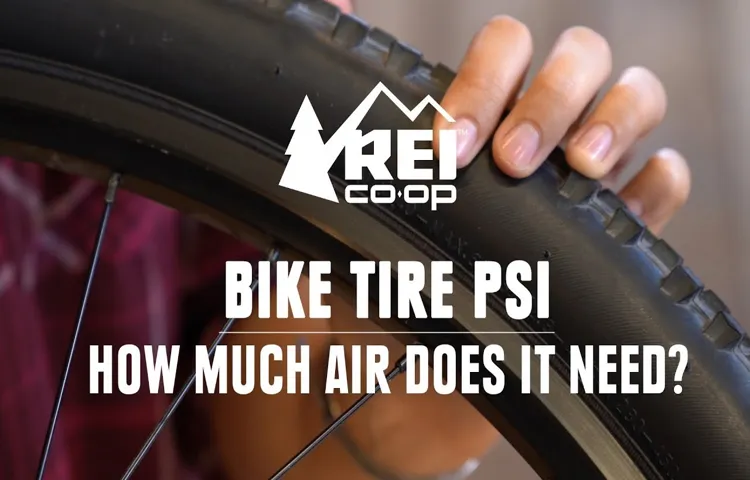Are you tired of guessing how much air your tires can hold? Do you have a tire pressure gauge, but don’t know how to use it effectively? Well, fear not, as we have you covered with a fun and informative video on how much air a tire can hold! In this video, we will take you through the basics of tire pressure, the importance of maintaining proper tire pressure, and how to determine the correct amount of air your tire can hold. Plus, we’ll provide handy tips on how to check your tire pressure and fill up your tires when needed. By the end of this video, you’ll have all the knowledge and confidence you need to keep your tires in top shape and maximize their performance.
So, sit back, relax, and let’s get rolling with our tire pressure video!
Table of Contents
Introduction
Have you ever wondered how much air your tire can hold? Well, wonder no more. In this video, we will explore the inner workings of tires and their capacity for air. Knowing how much air your tire can hold is important for proper inflation and safe driving.
Overinflating a tire can cause it to burst, while underinflation can lead to poor fuel efficiency and tire wear. The amount of air a tire can hold varies depending on the size and type of tire. The maximum air pressure for a tire is usually indicated on the sidewall of the tire.
It’s important to never exceed this maximum pressure. In this video, we’ll demonstrate the proper way to inflate your tires and ensure they’re operating at their maximum capacity. So buckle up and let’s dive into the world of tire inflation!
What is tire pressure and why is it important?
Tire pressure refers to the amount of air inside the tires of a vehicle, measured in pounds per square inch (PSI). Maintaining the correct tire pressure is an important aspect of vehicle maintenance that many drivers overlook. The ideal tire pressure varies from vehicle to vehicle and can be found in the owner’s manual or on a sticker inside the driver’s side door.
Driving on underinflated or overinflated tires can lead to several problems, including increased fuel consumption, decreased tire lifespan, poor handling, and even tire blowouts. Properly inflating your tires can help ensure your vehicle performs optimally, provides better fuel efficiency, and increases the overall safety of your vehicle.

Factors that affect tire pressure
Tire pressure is one of the most critical factors that affect vehicle performance and safety, yet many drivers overlook its significance. The right tire pressure not only ensures a smooth ride but also maximizes fuel efficiency, prolongs tire life, and enhances vehicle stability. Conversely, incorrect tire pressure can lead to poor handling, reduced fuel economy, increased tire wear, and even accidents.
Therefore, it is essential to understand the factors that influence tire pressure, such as temperature changes, altitude, load weight, and tire size. These variables can alter the air pressure in your tires, either overinflating or underinflating them, and ultimately compromising your driving experience. By keeping an eye on your tire pressure and considering these factors, you can ensure optimal performance, safety, and comfort on the road.
Determining the correct tire pressure
When it comes to ensuring the safety and longevity of your tires, one of the most important factors to consider is tire pressure. But how much air can a tire hold? The answer varies depending on the size and type of tire you are dealing with, but it is usually indicated on the sidewall of the tire itself. It is important to follow the manufacturer’s recommended tire pressure, as this will ensure optimal performance and help prevent blowouts or other dangerous situations on the road.
If you are unsure about the correct tire pressure for your particular vehicle and tires, consult your owner’s manual or a professional mechanic. Remember, keeping your tires properly inflated is a simple but crucial step in maintaining the safety and functionality of your vehicle.
Using the tire pressure label on the vehicle
One of the most crucial aspects of maintaining your vehicle’s tire health is checking and setting the correct tire pressure. The tire pressure label on the vehicle provides essential information that you need to determine the ideal tire pressure. This label is typically located on the driver’s door frame and contains the recommended psi (pounds per square inch) for your vehicle’s front and rear tires.
It’s essential to note that the recommended tire pressure can vary based on the type of vehicle and its loading condition, so ensure that you follow the tire pressure label’s guidelines for your particular make and model. Keeping your tires inflated to the correct pressure can increase fuel efficiency, maximize tire life, and, most importantly, promote safety on the road. So, take the time to check your tire pressure regularly and adjust it according to the label’s recommendations for a smooth and safe driving experience.
Checking tire pressure with a gauge
When it comes to maintaining your car, checking your tire pressure is an essential aspect that you shouldn’t overlook. Proper tire pressure ensures that you get optimal mileage, better handling, and improved stability. To determine the correct tire pressure, you need to check the recommended PSI (pounds per square inch) that should be listed on the owner’s manual or sticker on the car door jamb.
Once you have this figure, you can use a tire pressure gauge to check the pressure level accurately. Using a tire pressure gauge is a simple process that involves attaching the gauge to the tire valve and reading the measurement displayed on the gauge. If the reading is above the recommended PSI, use a tire pressure gauge to deflate the excess air.
On the other hand, if the reading is below the recommended PSI, add enough air until you reach the desired pressure. It’s important to note that you should confirm the tire pressure several times a year, especially during temperature changes or when your car has been parked for a long time. In conclusion, checking tire pressure with a gauge is a routine maintenance practice that ensures optimal tire performance and longevity.
By determining the correct tire pressure and using a gauge to accurately measure pressure levels, you’ll be able to enjoy a safer and more comfortable ride. So, always take the time to check your tire pressure regularly to maintain your car’s overall health and efficiency.
How to add more air to your tires
Adding air to your tires can seem like a daunting task. However, it is important to maintain proper tire pressure to ensure your safety on the road and prolong the life of your tires. The first step in adding air is determining the correct tire pressure for your vehicle.
This information can typically be found in your vehicle’s owner manual or on the tire information placard located on the driver’s side doorjamb. Remember, the correct tire pressure can vary depending on the make and model of your vehicle, so make sure to double-check the recommended pressure before adding air. Using a tire pressure gauge, check the current pressure of each tire and compare it to the recommended pressure.
If the pressure is too low, add air until it reaches the recommended level. Remember to replace the valve cap securely after adding air to each tire. By regularly checking and maintaining proper tire pressure, you’ll have a smoother, safer, and more fuel-efficient ride.
Conclusion
In the end, it’s not about how much air a tire can hold, but rather how much pressure it can handle. The right amount of air in your tires ensures better handling, fuel efficiency, and tire life. So the next time you’re filling up your tires, don’t just inflate them to their max capacity – pay attention to the recommended pressure.
Your wallet (and your car) will thank you.”
FAQs
What is the maximum air pressure a tire can hold?
The maximum air pressure a tire can hold will be mentioned on the sidewall of the tire. It is usually between 30 to 35 psi.
How often should I check my tire’s air pressure?
It is recommended to check your tire’s air pressure at least once a month.
What are the consequences of overinflated or underinflated tires?
Overinflated tires can cause a rough ride and wear out the center treads of the tire quickly. Underinflated tires can cause poor fuel economy, poor handling, and wear out the edges of the tire faster.
Can overfilling a tire cause damage to the tire or vehicle?
Yes, overfilling a tire can cause the tire to blowout, which can cause damage to the vehicle and potentially cause an accident.
What is the difference between psi and bar in tire pressure measurements?
PSI (pounds per square inch) is the measurement used in the United States, while bar is used in other parts of the world. 1 bar is equal to 14.5 psi.
How do I know when my tire needs to be replaced?
If the tread on your tire is below 2/32 of an inch, then it’s time to replace the tire. You can also look for signs of damage such as cracks, punctures, or bulges.
Can changing the tire size affect the amount of air pressure needed?
Yes, changing the tire size can affect the amount of air pressure needed. It’s important to consult your vehicle’s manual or a tire professional to determine the correct air pressure for the new tire size.


